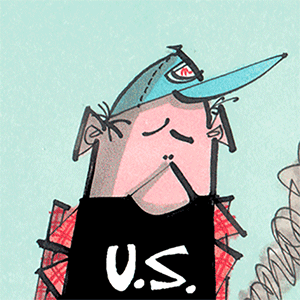Lara Williams: Trump isn't the biggest threat facing Greenland
Published in Op Eds
Greenland is one of the few places on Earth where climate change is sometimes referred to as an opportunity by making it less inhabitable for those who live there and more accessible to those who don’t, a point not missed by leaders elsewhere. With the landmass no longer safely insulated by sea ice, the world is knocking on Greenland’s door.
But it’s not all upside: Even while the effects of a warming planet open up new revenue streams for Greenland’s 57,000-strong population via mining, shipping and tourism, they’ll also have to reckon with potential losses of heritage and new weather risks.
The Arctic is often referred to as a canary in the coal mine when it comes to the climate. The polar region is at the frontline of the crisis, warming nearly four times faster than the global average rate between 1979 and 2021. Every year, scientists head to Greenland’s vast ice sheet with measuring devices. But Inuit, the indigenous peoples who make up the majority of the island’s population, don’t need specialist equipment to study the transformation – they’ve seen the changes with their own eyes.
Pelle Tejsner, an anthropologist at Ilisimatusarfik, the University of Greenland, told me that Inuit have observed the wind growing stronger, hindering the formation of sea ice. For hundreds of years, Inuit traversed the terrain on dogsleds to fish and hunt. In a single generation, that tradition has become endangered by thin ice and less predictable weather.
In a territory with almost no roads, the changing conditions risk isolating remote communities, while the decline in subsistence hunting has implications for food security as 32% of residents collect half or more of their food from the wild, according to a 2018-2019 survey. But it’s the loss of tradition that may be hardest to deal with. After all, heritage – both intangible and material – is linked to human well-being and social cohesion. Both are being lost in a warming Arctic.
The consequences are already becoming visible, with a decline in the number of sled dogs and people moving to modern jobs from subsistence lifestyles. The latter may not be such a bad thing – but after already suffering greatly from colonialism at the hands of Denmark, it’s yet another blow to indigenous identity and culture in the region.
Half the respondents to the survey of Greenland residents said that climate change would harm people in the autonomous territory. But many also said it will benefit farming, tourism, shipping and mining. Others, when asked to think of ways warming will affect them and their families, cited some benefits including “bigger potatoes,” “more fish” and “greater business opportunities.”
There may well be positives for Greenland: Warming temperatures and receding glaciers make precious minerals easier to access, extend the growing season on the south of the island, bring new species of fish to the self-ruling territory’s waters, promise to open up new trade routes and extend the tourism season.
The island’s mineral wealth and strategic location are why U.S. President Donald Trump has said, once again, that he wants to buy the territory. Trump’s comments were followed up with a visit by his son and an influx of red MAGA hats into the capital, Nuuk. Both the Danish and Greenlandic prime ministers have stressed that Greenland is not for sale.
But increasingly, unstable weather conditions mean that even these benefits can’t be relied upon. Summers whiplash between being extremely rainy or very dry, which is straining agriculture in the region. Depending on the weather, farmers have been left without hay for winter feed or with sodden crops. Contrary to expectations, the number of farms has actually shrunk in recent years.
Greenland’s fishing industry, which provides more than 80% of the territory’s export income, has enjoyed bumper hauls and new species moving north as oceans warm. But, as well as stormier seas, receding glaciers are blasting out mud. This nutrient-rich silt, known as glacial rock flour, isn’t all bad — it can be used as fertilizer on crops and absorbs carbon dioxide from the air — but its presence reduces visibility for fishermen and forces fish into deeper waters, where they’re also out of reach of the nets. It also posed problems in 2023 for a luxury cruise ship which was stuck in the mud off the eastern coast of the island for three days.
Tourism is seen as a promising source of income for Greenlanders, but that’s also accompanied by a paradox. Climate change allows more people to visit, but tourists arriving via cruise ships or on international flights into a newly expanded airport generate carbon emissions that exacerbate the problem.
As Birger Poppel, project chief emeritus of the Survey of Living Conditions in the Arctic at Ilisimatusarfik, pointed out to me, the impacts of climate change on Inuit’s traditional lifestyle may also devalue tourism in the area.
One of the highlighted experiences on Greenland’s official tourism website, for example, is dogsledding. But as mentioned above, climate change is making the sea ice thinner and more unstable in a larger part of the winter season, limiting both tourist and hunting activities based on sled-pulling pooches.
Climate isn’t the only thing that’s changing on the island. With an election coming up this year, Greenlanders are facing debates over the territory’s independence and future ties to global powers. The right question may not be “is climate change an opportunity?” but rather: “Who are we in a changing climate?”
_____
This column does not necessarily reflect the opinion of the editorial board or Bloomberg LP and its owners.
Lara Williams is a Bloomberg Opinion columnist covering climate change.
_____
©2025 Bloomberg L.P. Visit bloomberg.com/opinion. Distributed by Tribune Content Agency, LLC.




























































Comments